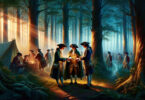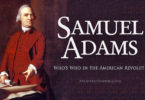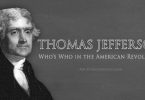If you ever saw the Broadway musical “1776,” or its movie version made in 1972, you probably know all you think you need to know about John Adams. He was, after all, the main character in that show, and the first song in it was the whole Continental Congress telling him how he should just sit down and shut up. He comes across as rather bossy and annoying in parts of the musical, but also as a loving husband and as someone who is genuinely passionate about what he is doing. Though you can tell why other members of the Continental Congress don’t like him, you can also see the humanity in him, and the show makes it almost seem as if the entire Revolution were his doing. You can’t help but root for him.
Of course, the musical just tell one small part of John Adams’s tale. It focuses tightly on the events in the Continental Congress during the summer of 1776 that led to the writing of the Declaration of Independence (in the musical, Jefferson only sits down to write the thing after Adams and Franklin bring Jefferson’s wife all the way from Virginia to Pennsylvania to spend some quality time with him… an event that never actually occurred in real life). John Adams the man, and his contribution to the American Revolution were so much more than just that one slice in time.
Born October 30, 1735, John Adams was the eldest of the children of John Adams, Sr. and Susanna Boylston. His birthplace in Braintree, Massachusetts is now a historical park. His parents both came from staunchly Puritan backgrounds and were descendants of some of the earliest English settlers in North America. His mother’s family, in particular, were well known as a long line of medical practitioners. As the eldest child, John was expected to get a formal education and attended local grammar and Latin schools at a young age. He did not like these schools, and was often truant; he expressed a desire to be a farmer, something he continued dabbling in his entire life, during the brief periods when public life did not call upon him.
He did not wish to continue with school, but, as he recalled in his own writings, his father ordered him, saying, “You shall comply with my desires.” After that, and hiring a new teacher John liked better, John stayed in school, and eventually enrolled at Harvard University at age 16.
One way he did go his own way rather than what his father wanted was when he decided against studying to go into the ministry. He determined he wanted “honor of reputation,” and deference from his fellow students. He thought that could best be achieved by a career in law, which he pursued, and entered upon graduation.
John eventually became one of the top lawyers in Boston and began delving into the world of politics with a series of anonymously written essays to the newspaper, including one that was critical of the British Stamp Act imposed on the colonies. When the French and Indian War broke out, most young men of his class in society did not participate; those who signed up to be soldiers were from less well-off families who needed the money. Even so, John struggled with his decision to not join the fight, as he was acutely aware he was the first man in his direct male line in America to not be a member of some militia.
When criticisms and protests against the policies of Great Britain broke out in the colonies, John was among the critics. At first, he was overshadowed in popularity in revolutionary circles by his cousin, Samuel Adams. However, John eventually made a strong name for himself. The name he made was as good, honest man who believed in independence for his country, but who would also do what was right. That is why his reputation as a good revolutionary was maintained even after he was the only lawyer in Boston who was willing to defend the British soldiers involved in the infamous Boston Massacre.
In the midst of his law practice, political activities, and involvement with the young revolutionary movement, John married his third cousin, Abigail Smith, daughter of William Smith (a reverend) and Elizabeth Quincy. They had six children together, four of whom lived to adulthood, and two of whom outlived him and Abigail. One of these was the future sixth president of the United States, John Quincy Adams (who is also the first person who was president of the United States to have his photograph taken, shortly after the invention of that technology).
In 1772, the British imposed the Coercive Acts and the Tea Act on Massachusetts, in reprisal for previous rebellions there. By singling out Massachusetts for this treatment, it was hoped by the British Parliament that the other colonies would fall in line with Britain. Revolutionaries in Boston asked John to voice their objections to Parliament. In his two letters to Britain, he argued the charter of Massachusetts was between the colony and the king, and that they had never been under Parliament’s law. In John’s opinion, if the colony and the king could not come to an accord together, then American independence was the only solution. It was one of the first public suggestions of independence.
By 1775, John was an elected member of the Continental Congress in Philadelphia from the colony of Massachusetts. At first, he publicly stated reconciliation with Britain was preferable if it was practicable. However, in private, he told Benjamin Franklin he believed independence was inevitable. By later that year, no one was more of an outspoken proponent of independence at the Congress than John, which is the basis of the “1776” musical.
John Adams suggested Jefferson write a document declaring independence, though Jefferson thought Adams should do it. Adams insisted a Virginian like Jefferson should be the writer, and also that Jefferson could write better than him. Adams did do some editing to Jefferson’s first draft.
Once the Declaration was accepted by the Continental Congress, the Revolution was on, and no one was busier than John Adams. He sat on 90 war committees and worked eighteen-hour days regularly during the Revolution. He was referred to by others in the Congress as a one-man war department.
Once the war was over, Adams became America’s first diplomatic ambassador to Great Britain. He only learned many years later that his name was one of the several revolutionary leaders excluded from being given a pardon if the British had won the war.
After Adams’s service abroad, he became George Washington’s vice-president, after the Articles of Confederation were set aside for a new type of government with the Constitution. Then, he became the second president of the new nation he was instrumental in helping create. Without the passion of John Adams, there may have been no Declaration of Independence or revolution at all. Our freedom as an independent nation rests largely on his shoulders, and he earned his place as an honored Founding Father in our nation’s history.






